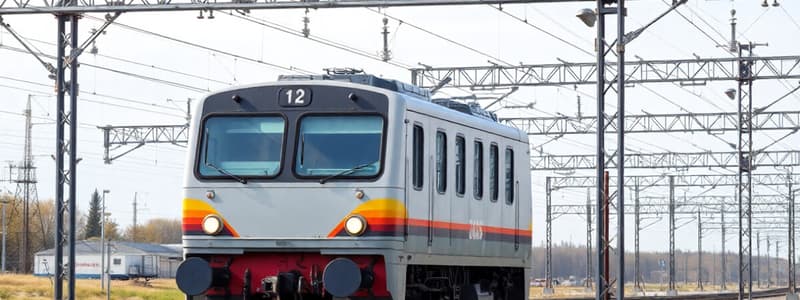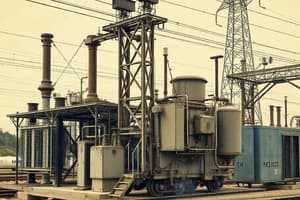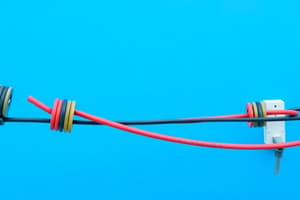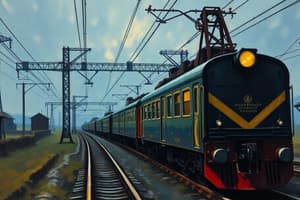Podcast
Questions and Answers
What is the primary frequency of power supply for electric traction?
What is the primary frequency of power supply for electric traction?
- 55 Hz
- 48.5 Hz
- 60 Hz
- 50 Hz (correct)
What voltage range must be maintained at the feeding posts for reliable traction supply?
What voltage range must be maintained at the feeding posts for reliable traction supply?
- 20 kV to 22 kV
- 22 kV to 24 kV
- 25 kV to 27.5 kV (correct)
- 28 kV to 30 kV
What is one of the key responsibilities of the Railway concerning power supply reliability?
What is one of the key responsibilities of the Railway concerning power supply reliability?
- To ensure supply system is completely independent of Supply Authorities
- To reduce traction loads during peak periods
- To establish periodic meetings with Supply Authorities (correct)
- To supply power from alternative sources
Which of the following measures is NOT suggested for maintaining power supply reliability?
Which of the following measures is NOT suggested for maintaining power supply reliability?
What cumulative effect can short-duration power supply interruptions have on Railway operations?
What cumulative effect can short-duration power supply interruptions have on Railway operations?
When are the traction voltage limits particularly emphasized during meetings with Supply Authorities?
When are the traction voltage limits particularly emphasized during meetings with Supply Authorities?
What action is required if traction load is not treated as an essential load?
What action is required if traction load is not treated as an essential load?
What is one of the items that must be checked before passing bills from the Supply Authorities?
What is one of the items that must be checked before passing bills from the Supply Authorities?
Which condition is necessary to avoid penalties related to power factor at traction sub-stations?
Which condition is necessary to avoid penalties related to power factor at traction sub-stations?
What should be done in case of any disputes or discrepancies related to billing?
What should be done in case of any disputes or discrepancies related to billing?
When planning power factor improvement, which sub-station should be prioritized?
When planning power factor improvement, which sub-station should be prioritized?
What should be done if the average monthly power factor is calculated?
What should be done if the average monthly power factor is calculated?
What is required for the power supply for electric traction before it can be taken?
What is required for the power supply for electric traction before it can be taken?
What happens when the grid supply to a traction sub-station fails?
What happens when the grid supply to a traction sub-station fails?
What principle regarding maximum demand has been agreed upon by most supply authorities for billing purposes?
What principle regarding maximum demand has been agreed upon by most supply authorities for billing purposes?
How is the railways' traction power recommended to be charged according to the latest methodology?
How is the railways' traction power recommended to be charged according to the latest methodology?
What aspect of electric traction costs is highlighted as substantial?
What aspect of electric traction costs is highlighted as substantial?
What should be considered in the tariff structure for electric traction?
What should be considered in the tariff structure for electric traction?
What should the contract demand for each sub-station relate to?
What should the contract demand for each sub-station relate to?
What is a consequence of not finalizing the power supply agreement promptly?
What is a consequence of not finalizing the power supply agreement promptly?
Who bears the cost of the equipment needed for the methodology changes regarding the charging of traction power?
Who bears the cost of the equipment needed for the methodology changes regarding the charging of traction power?
What is the preferred notice period for altering Contract Demand?
What is the preferred notice period for altering Contract Demand?
What should be considered to minimize the energy bill in electric traction?
What should be considered to minimize the energy bill in electric traction?
What happens when the power factor falls below a specified value?
What happens when the power factor falls below a specified value?
How is the billing demand usually determined?
How is the billing demand usually determined?
What is the excess energy calculation based on?
What is the excess energy calculation based on?
What is a common minimum guarantee percentage return stipulated in agreements?
What is a common minimum guarantee percentage return stipulated in agreements?
What charge accounts for variations in fuel costs and calorific value?
What charge accounts for variations in fuel costs and calorific value?
What is a consequence of exceeding the Contract Demand for just 15 minutes?
What is a consequence of exceeding the Contract Demand for just 15 minutes?
What should be done to avoid penal charges related to Contract Demand?
What should be done to avoid penal charges related to Contract Demand?
What is typically true about the energy charge in electric traction?
What is typically true about the energy charge in electric traction?
How should billing figures be calculated when a second set of meters is provided at Railways' cost?
How should billing figures be calculated when a second set of meters is provided at Railways' cost?
Who is responsible for taking the monthly meter readings?
Who is responsible for taking the monthly meter readings?
What additional information should a supervisory official obtain during meter readings at grid sub-stations?
What additional information should a supervisory official obtain during meter readings at grid sub-stations?
Why should the Supply Authorities' bills be carefully scrutinized?
Why should the Supply Authorities' bills be carefully scrutinized?
What should be done if the minimum charge payable exceeds the actual energy consumption?
What should be done if the minimum charge payable exceeds the actual energy consumption?
When are the readings recorded for billing considered valid?
When are the readings recorded for billing considered valid?
What might Supervisory officials suggest regarding the Supply Authority's network?
What might Supervisory officials suggest regarding the Supply Authority's network?
What is laid down jointly with the Accounts Department in relation to bill scrutiny?
What is laid down jointly with the Accounts Department in relation to bill scrutiny?
What does the term 'penal charges' refer to in the context of bill scrutiny?
What does the term 'penal charges' refer to in the context of bill scrutiny?
What should be done to prevent the recurrence of penal charges?
What should be done to prevent the recurrence of penal charges?
What is a key consideration when selecting kVAr ratings for power factor improvement capacitors?
What is a key consideration when selecting kVAr ratings for power factor improvement capacitors?
Which of the following should NOT be checked prior to passing bills from the Supply Authorities?
Which of the following should NOT be checked prior to passing bills from the Supply Authorities?
In a scenario of significant departures in billing, what action is recommended?
In a scenario of significant departures in billing, what action is recommended?
Which condition should be maintained concerning the average monthly power factor?
Which condition should be maintained concerning the average monthly power factor?
What is the priority in planning for power factor improvement at traction sub-stations?
What is the priority in planning for power factor improvement at traction sub-stations?
What principle should be accepted by Supply Authorities regarding maximum demand during emergency working?
What principle should be accepted by Supply Authorities regarding maximum demand during emergency working?
How should the tariff structure for electric traction be approached to reduce costs?
How should the tariff structure for electric traction be approached to reduce costs?
What must the contract demand for each sub-station be related to?
What must the contract demand for each sub-station be related to?
What is the role of the Central Electricity Authority in relation to billing for traction power?
What is the role of the Central Electricity Authority in relation to billing for traction power?
What is indicated by variations in billing demand charges for electric traction?
What is indicated by variations in billing demand charges for electric traction?
What action is recommended if the electricity supply agreement has not been finalized?
What action is recommended if the electricity supply agreement has not been finalized?
Who is responsible for bearing the cost of the equipment required for implementing the new methodology for traction power charging?
Who is responsible for bearing the cost of the equipment required for implementing the new methodology for traction power charging?
What is the penalty mechanism prescribed if the power factor falls below a certain value?
What is the penalty mechanism prescribed if the power factor falls below a certain value?
Which component does NOT affect the computation of excess energy charges?
Which component does NOT affect the computation of excess energy charges?
What is typically defined as billing demand?
What is typically defined as billing demand?
What element should be checked periodically with Supply Authorities regarding charges?
What element should be checked periodically with Supply Authorities regarding charges?
In determining the Contract Demand, which condition must be considered to avoid penal charges?
In determining the Contract Demand, which condition must be considered to avoid penal charges?
If excess energy is computed, how is it typically calculated according to the given formula?
If excess energy is computed, how is it typically calculated according to the given formula?
What minimum return percentage on capital cost is typically guaranteed in agreements with SEBs?
What minimum return percentage on capital cost is typically guaranteed in agreements with SEBs?
Which of the following does NOT feature in the careful consideration for energy bill reduction?
Which of the following does NOT feature in the careful consideration for energy bill reduction?
How might two sets of trivector meters influence Maximum Demand charges?
How might two sets of trivector meters influence Maximum Demand charges?
What should be the basis for billing when a second set of meters is provided at Railways' cost?
What should be the basis for billing when a second set of meters is provided at Railways' cost?
Who initiates the meter card and printomaxigraph chart reading for joint recording?
Who initiates the meter card and printomaxigraph chart reading for joint recording?
Which of the following additional information is NOT typically collected during meter readings at grid substations?
Which of the following additional information is NOT typically collected during meter readings at grid substations?
What action should be taken if the billed amount exceeds actual energy consumption due to minimum charges?
What action should be taken if the billed amount exceeds actual energy consumption due to minimum charges?
What is the main purpose of scrutinizing the Supply Authorities' bills in the Divisional office?
What is the main purpose of scrutinizing the Supply Authorities' bills in the Divisional office?
What is one of the key recommendations for ensuring prompt payment rebates regarding bill scrutiny?
What is one of the key recommendations for ensuring prompt payment rebates regarding bill scrutiny?
What might supervisory officials suggest during their visits to grid substations?
What might supervisory officials suggest during their visits to grid substations?
Which element is crucial for accepting readings for billing purposes?
Which element is crucial for accepting readings for billing purposes?
What should be done in response to penal charges levied on bills?
What should be done in response to penal charges levied on bills?
Where should a notification be directed if there is an excess of penalties related to the actual energy consumption?
Where should a notification be directed if there is an excess of penalties related to the actual energy consumption?
What is the maximum allowable total harmonic voltage distortion (Vt) at the point of supply?
What is the maximum allowable total harmonic voltage distortion (Vt) at the point of supply?
What is a potential consequence of setting the contract demand too high?
What is a potential consequence of setting the contract demand too high?
When conducting harmonic analysis, what is the RMS value of the fundamental voltage denoted as?
When conducting harmonic analysis, what is the RMS value of the fundamental voltage denoted as?
What is the stipulated percentage for the individual harmonic distortion (Vn) limit?
What is the stipulated percentage for the individual harmonic distortion (Vn) limit?
Why is it necessary to strike a balance between high and low contract demand?
Why is it necessary to strike a balance between high and low contract demand?
What should be conducted annually on the supply authority’s meter to ensure accuracy?
What should be conducted annually on the supply authority’s meter to ensure accuracy?
What is the maximum average load factor stipulated for contracts?
What is the maximum average load factor stipulated for contracts?
What does the formula for calculating total harmonic voltage distortion (Vt) involve?
What does the formula for calculating total harmonic voltage distortion (Vt) involve?
Why should the rates charged for traction be periodically reviewed with the SEB?
Why should the rates charged for traction be periodically reviewed with the SEB?
What factor could lead to failure in achieving the minimum average load factor?
What factor could lead to failure in achieving the minimum average load factor?
Flashcards
Electric Traction Power Source
Electric Traction Power Source
Single-phase 50 Hz power for electric trains comes from a step-down transformer connected to a 220/132/110/66 kV three-phase grid.
Traction Substation Feeders
Traction Substation Feeders
Two-phase duplicate feeders deliver power to traction substations from the supply authority’s substation.
Power Supply Reliability
Power Supply Reliability
Ensuring continuous and dependable power for trains.
Power Supply Liaison
Power Supply Liaison
Signup and view all the flashcards
Voltage & Frequency Limits
Voltage & Frequency Limits
Signup and view all the flashcards
Traction Load Priority
Traction Load Priority
Signup and view all the flashcards
Power Supply Interruptions Review
Power Supply Interruptions Review
Signup and view all the flashcards
Power Supply Agreement
Power Supply Agreement
Signup and view all the flashcards
Emergency Grid Supply
Emergency Grid Supply
Signup and view all the flashcards
Shared Grid Transformer Electricity
Shared Grid Transformer Electricity
Signup and view all the flashcards
Electric Traction Energy Cost
Electric Traction Energy Cost
Signup and view all the flashcards
Varying Electricity Tariffs
Varying Electricity Tariffs
Signup and view all the flashcards
Contract Demand
Contract Demand
Signup and view all the flashcards
Maximum Demand
Maximum Demand
Signup and view all the flashcards
SEB (State Electricity Boards)
SEB (State Electricity Boards)
Signup and view all the flashcards
Simultaneous Maximum Demand
Simultaneous Maximum Demand
Signup and view all the flashcards
Notice Period for Contract Demand Change
Notice Period for Contract Demand Change
Signup and view all the flashcards
Maximum Demand (MD) Charge
Maximum Demand (MD) Charge
Signup and view all the flashcards
Energy Charge
Energy Charge
Signup and view all the flashcards
Fuel Adjustment Charge (FAC)
Fuel Adjustment Charge (FAC)
Signup and view all the flashcards
Low Power Factor Penalty
Low Power Factor Penalty
Signup and view all the flashcards
Billing Demand
Billing Demand
Signup and view all the flashcards
Excess Demand Charge
Excess Demand Charge
Signup and view all the flashcards
Excess Energy Calculation
Excess Energy Calculation
Signup and view all the flashcards
Contract Demand (CD)
Contract Demand (CD)
Signup and view all the flashcards
Minimum Guarantee
Minimum Guarantee
Signup and view all the flashcards
Bill Checking Instructions
Bill Checking Instructions
Signup and view all the flashcards
Power Factor Improvement
Power Factor Improvement
Signup and view all the flashcards
When to Use Capacitors?
When to Use Capacitors?
Signup and view all the flashcards
Average Monthly Power Factor
Average Monthly Power Factor
Signup and view all the flashcards
Pre-Planned Traction Supply Shut-Downs
Pre-Planned Traction Supply Shut-Downs
Signup and view all the flashcards
Billing Procedure (Railways)
Billing Procedure (Railways)
Signup and view all the flashcards
Monthly Meter Reading
Monthly Meter Reading
Signup and view all the flashcards
Additional Grid Data
Additional Grid Data
Signup and view all the flashcards
Scrutinizing Bills
Scrutinizing Bills
Signup and view all the flashcards
Agreement and Tariff
Agreement and Tariff
Signup and view all the flashcards
Prompt Payment Rebates
Prompt Payment Rebates
Signup and view all the flashcards
Penal Charges
Penal Charges
Signup and view all the flashcards
Minimum Charge Issue
Minimum Charge Issue
Signup and view all the flashcards
Joint Representatives
Joint Representatives
Signup and view all the flashcards
Power Reliability
Power Reliability
Signup and view all the flashcards
Notice Period for Contract Demand
Notice Period for Contract Demand
Signup and view all the flashcards
Maximum Demand Charge
Maximum Demand Charge
Signup and view all the flashcards
Penalty for Low Power Factor
Penalty for Low Power Factor
Signup and view all the flashcards
Guaranteed Load Factor
Guaranteed Load Factor
Signup and view all the flashcards
Harmonics
Harmonics
Signup and view all the flashcards
Harmonic Distortion Limits
Harmonic Distortion Limits
Signup and view all the flashcards
Periodic Tariff Review
Periodic Tariff Review
Signup and view all the flashcards
Meter Reading & Testing
Meter Reading & Testing
Signup and view all the flashcards
Joint Meter Reading
Joint Meter Reading
Signup and view all the flashcards
Meter Reading Procedure
Meter Reading Procedure
Signup and view all the flashcards
Average Meter Readings
Average Meter Readings
Signup and view all the flashcards
Grid Data Collection
Grid Data Collection
Signup and view all the flashcards
Bill Scrutiny
Bill Scrutiny
Signup and view all the flashcards
Power Reliability Improvement
Power Reliability Improvement
Signup and view all the flashcards
Joint Representatives Collaboration
Joint Representatives Collaboration
Signup and view all the flashcards
Contract Demand Change Notice Period
Contract Demand Change Notice Period
Signup and view all the flashcards
Study Notes
Power Supply for Traction
- Single-phase 50 Hz power for electric traction is obtained from 220/132/110/66 kV extra high voltage 3-phase grid system via step-down transformers.
- Duplicate feeders (only 2 phases) run from the supply authority's substation to the traction substation.
- A schematic diagram of the traction substation and feeding arrangement is in Figure 1.01.
- 25kV single-phase conventional system is used on Indian Railways.
Liaison with Power Supply Authorities
- Regular meetings between Railway and Supply Authority officials at various levels are vital for consistent power supply.
- Traction voltage (25 kV to 27.5 kV) at feeding posts and frequency (48.5 Hz to 51.5 Hz) must be maintained.
- Traction load is treated as essential and shouldn't be disconnected, as agreed by most Supply Authorities.
- Railway authorities should actively work with supply authorities to maintain these voltage and frequency levels.
- Periodical reviews of power supply interruptions are essential.
- A specific agreement must be in place between the Railway and Supply Authority before power supply for traction is established.
Tariff for Traction
- Energy costs are a substantial part of traction operations. Tariffs vary from flat rates to complex structures, including parameters like maximum demand, energy use, and fuel adjustment.
- Contract demand should be stipulated realistically, avoiding penalties related to exceeding or failing to meet the contract.
- Shorter notice periods for altering contract demand are preferable.
- Factors like maximum demand, energy charge (paisa/kWh), and fuel adjustment charge (FAC) significantly influence energy bills.
Power Factor Improvement
- Installing power factor improvement capacitors at 25kV traction substation buses is crucial.
- Prioritizing substations that feed large marshalling yards or have low power factor penalties in their tariffs.
- Average monthly power factor calculation (kWh/kVAh) is essential. Ideally, keep power factor near unity.
Shut-Downs of Traction Supply
- Duplicate EHV feeders at grid and traction substations owned by the railways are essential for continuous service.
- Planning shut-downs well in advance is vital.
- Notifying the Supply Authority of shut-downs is crucial, along with the reasons and expected durations.
Monthly Meter Readings
- Meter readings should be taken jointly by supply authority and railway representatives each month.
- Meter accuracy should be verified periodically. An agreed-upon procedure for meter testing and usage is essential.
- Additional information like maximum demand, power factor, load factor, and voltage variation on interconnection should be documented.
Scrutiny of Bills
- Supply authority's bills need careful scrutiny in the Divisional office.
- A schedule should be established for bill review and payment to maximize rebates.
- Any discrepancies or charges related to minimum charges should be promptly brought to relevant authorities' attention.
- Accurate meter readings, tariff compliance, maximum demand calculations, and timeliness of payments should be verified when reviewing bills.
Statistical Data
- Monthly energy consumption statistics (kWh), maximum demand (kVA), average power factor, and monthly average load factor are crucial.
- Monthly payments for energy, maximum demand, meter rent, fuel surcharge, power factor surcharge, and any minimum guarantee load payments are required.
- Information should be consolidated and presented to the relevant authorities.
Studying That Suits You
Use AI to generate personalized quizzes and flashcards to suit your learning preferences.
Related Documents
Description
This quiz explores the principles and practices of power supply for electric traction systems, specifically focusing on the high voltage supply and voltage regulation in Indian Railways. It addresses key collaborations between railway and power supply authorities to ensure consistent delivery of traction voltage and frequency. Test your knowledge on the technical aspects and operational protocols involved in maintaining effective power supply.




